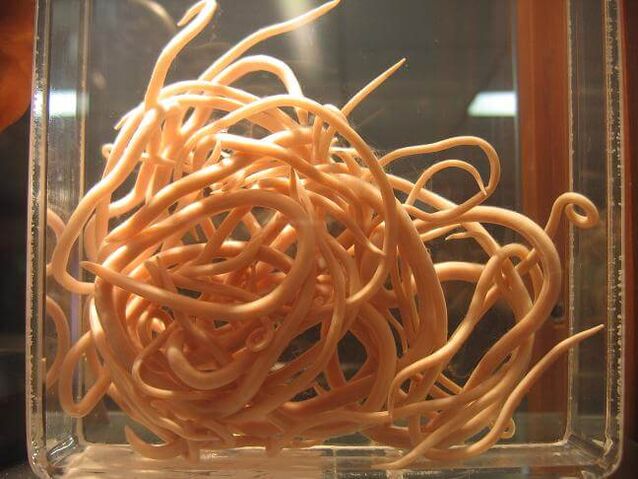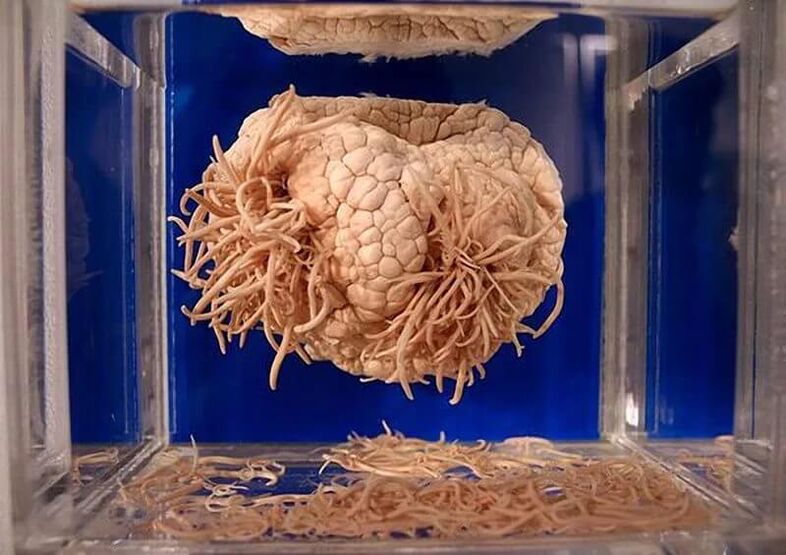Worms or helminths are parasites that live, feed, grow and reproduce in the human body, that is, they use it to implement their life cycle. According to various statistics, there are between 300 and 500 species of worms in the world that are dangerous to people. Its prevalence differs depending on the country and depends on the level of health culture of the population and the socioeconomic development of the region. But even in enlightened European countries, helminthiasis symptoms are found in a third of the inhabitants. Worm larvae can enter the human body in different ways, depending on their development cycle. The names of worms in humans, their varieties, as well as methods of infection, symptoms and treatment methods of helminthiasis are relevant information for the majority of the world's population.

What types of worms are there?
Over many years of evolution, parasites have ideally adapted to live at the expense of other living beings, without arousing suspicion in the immune system for a long time, which is why the symptoms of worms in humans do not appear immediately. and may be completely absent or mild. voiced.
Worms can imperceptibly penetrate the body, camouflage themselves, destroy tissues and organs, poison the human body with toxins and live in it for a long time.
Some types of worms are dangerous only to humans, while others are parasites of animals. Their sizes vary from microscopic to gigantic (15 or more meters in length). About three dozen parasites are common, including single-celled protozoa. Among all the diversity, there are 3 main groups of helminths according to the characteristics of their life cycle:
- Contact worms- found only in humans, they have a simple development cycle that does not require more than one host. Typical representatives are pinworms, which are the most common intestinal worms in children. Infection occurs in families, groups of children, public places through dirty hands, household items (toys, books, curtains, etc. ) on which mature eggs of these worms have fallen, as well as through inhalation of dust.
- Group of geohelminths– their eggs must first mature in soil, water or sand. They enter the human body through the mouth with unwashed berries, vegetables or herbs (such as roundworms and whipworms) or through the skin (as hookworms).
- Biohelminths– have a complex life cycle with a change of host. These worms appear in humans when eating poorly washed vegetables or raw water (echinococcus), meat from animals contaminated with larvae (bovine or porcine tapeworm), brushed fish and caviar (wide tapeworm), river fish (fluke or liver fluke) or through the bloodstream. (filaria).

types of worms
All types of helminths are divided into 3 classes according to their morphological characteristics:
- Class of nematodes (roundworms)– intestinal worms, pinworms, hookworms, whipworms, trichinella. Nematodes are distinguished by the presence of separate sexes and have different sizes, from 1 cm (female pinworms) to 40 cm (ascaris).
- Class of trematodes (usually called trematodes)– Siberian fluke (cat fluke), schistosomes. They are always biohelminths and hermaphrodites, equipped with various suction and attachment devices to internal organs of a person.
- Class of cestodes (type of flatworms)- These are long ribbon parasites. These include broad tapeworm, swine tapeworm, and bovine tapeworm; This is the largest worm, capable of growing up to 20 meters in length. Flatworms feed on the entire surface of the body, they are hermaphrodites and biohelminths. Echinococcus is considered the smallest representative of cestodes.
Great diversity and exceptional survival is what the world of worms is all about. The class of trematodes and cestodes are 100% parasitic, but nematodes are heterogeneous, there are several tens of thousands of species, but not all of them like to parasitize the human body. Most helminths lay eggs that can survive in the external environment for several months and Trichinella is a viviparous individual..
In the human body, worms live not only in the intestines, some of them prefer to locate in the liver, lung parenchyma, brain, skin, muscle tissue and even in the eyeballs.
Worms can live a long time; For example, a cysticercus can live in the brain for many years; The growth of a hydatid cyst continues for up to 10 years.
About roundworms
What worms are most common:
- pinworms- they live in the lower parts of the small intestine and throughout the large intestine of humans; Females lay eggs around the anus at night, which causes a characteristic sign of enterobiasis in humans: itching. Transmission of worms between people occurs through dirty hands (very often eggs of these worms are found under children's nails), bedding and household items. The eggs are very light and can become airborne with dust; They remain viable for up to six months. These are the least toxic of the worms. Human feces do not contain them, for diagnosis it is necessary to make a scraping of the perianal area.
- roundworms- a large worm with a curved hook-shaped end; a mature individual can reach a length of up to half a meter. The eggs mature in the soil and enter the stomach and small intestine with unwashed berries, vegetables or herbs. The released larvae gnaw at the intestinal wall, penetrate into the venous vessels of the liver, from there, with the blood flow, they rush to the lungs, the right parts of the heart, sometimes to the brain and eyes, and inflammation develops in these organs. When coughing, sputum with larvae enters the mouth and is swallowed back into the gastrointestinal tract, where mature individuals develop, laying eggs after a month. These worms are brown or reddish in color because they hijack red blood cells. The lifespan of intestinal worms is up to 2 years. For diagnosis, feces are analyzed for worm eggs.
- whipworm- a hair-thin worm, about 5 cm long and with a pointed end, with which it adheres to the inner surface of the intestinal wall. The eggs mature in the soil, from where they penetrate the intestines, from where the larvae emerge. Whipworms feed on blood and like to stay within the cecum and appendix, which often causes inflammation and anemia. Life expectancy is about 3-4 years. To detect it, it is necessary to analyze the feces for worm eggs.
- Trichinella- a small roundworm that moves between predators and livestock. A person becomes infected by eating meat with larvae, in the intestines, after a couple of days, a mature individual of Trichinella is formed, which then gives birth to live larvae. Through the blood they can infect the entire body, but they prefer the skeletal muscles, where they remain for up to 5 years.

About tapeworms and trematodes
What types of worms cause the most damage to the human body?
- Bull tapeworm (popularly called tapeworm)- It is considered the largest human worm (up to 15-20 meters) with a ribbon-shaped body of thousands of individual segments, among which the most mature ones are located in the tail and fall off as the eggs mature containing. These fragments are the size of a human fingernail, fall to the ground, to the grass and then end up in the body of the cattle. A person becomes infected through beef. The bovine tapeworm can live in a person's small intestine for up to 10 years and feeds on the entire surface of their body. For diagnosis, feces are examined.
- pork tapeworm– similar to the bull tapeworm, but shorter in length. If a person becomes infected with larvae, the tapeworm grows in their small intestine; When infested by eggs, the larvae migrate and can infect any organ.
- had wide– its type of worm is flat, more than 12 meters long. A person becomes infected by eating undersalted caviar, dried or undercooked fish. It can settle in the small intestine for decades, constantly releasing mature segments with larvae into the environment.
- echinococcus- the smallest parasite of the cestode class. Over several years, its larvae form cysts, which can be located in different organs and reach 10 cm or more in diameter. Infection occurs from sick dogs or livestock. The course is characterized by a pronounced clinical picture and the risk of complications.
- Feline fluke (liver)- a small worm that enters the human body when consuming undercooked freshwater fish, lives in the lumen of the small intestine, inside the bile and pancreatic ducts, can multiply rapidly and live up to two decades.
Despite the large variety of species, it is possible to determine quite accurately which worm lives in the human body using modern diagnostic methods and the old proven test - feces for helminth eggs.
Treatment is carried out after confirmation of the diagnosis and prescription of the treating doctor.






































